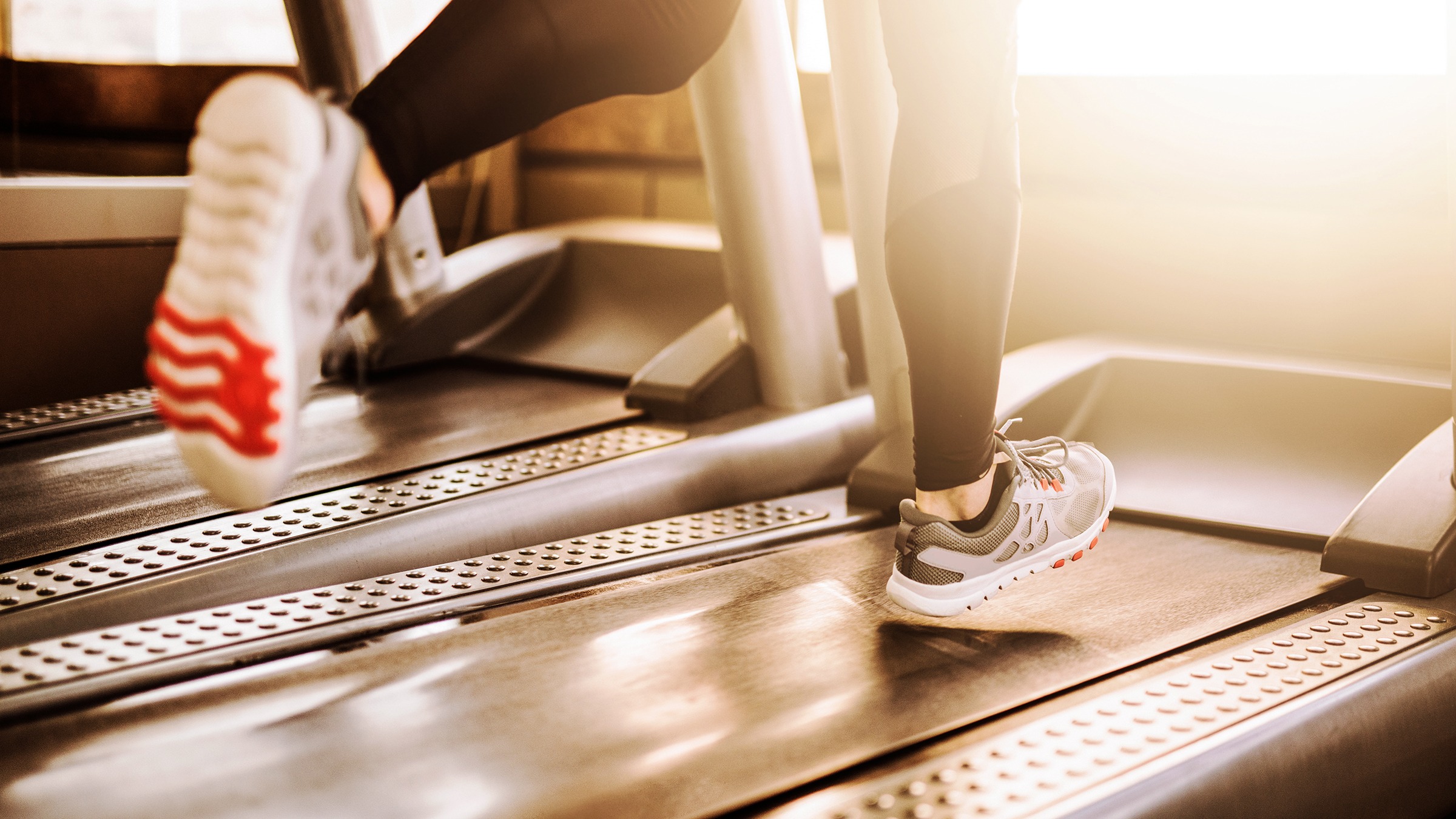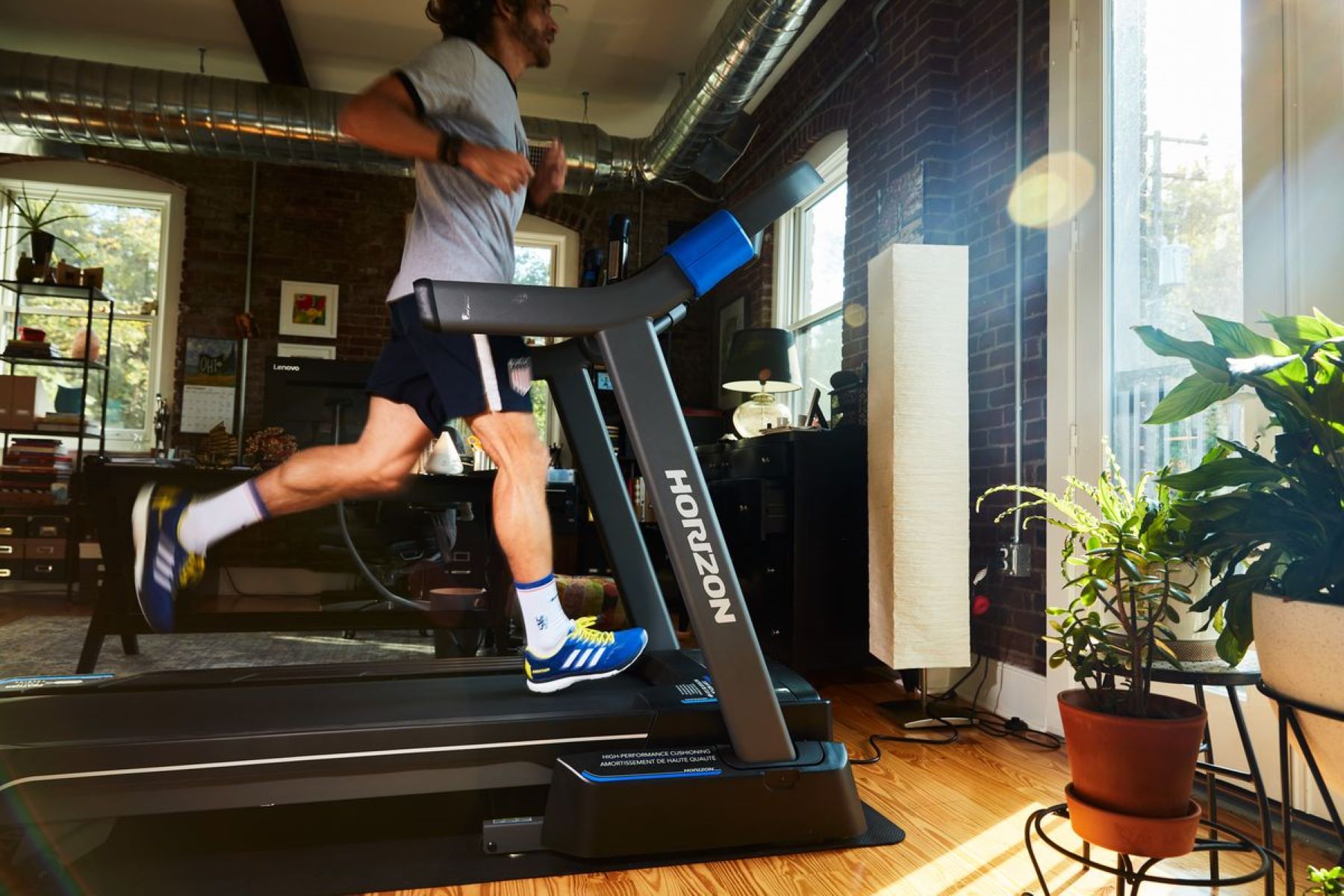

Featured
How To Build Endurance On A Treadmill
Modified: January 22, 2024
Learn how to build your endurance on a treadmill with our featured workouts, tips, and strategies. Increase your stamina and reach your fitness goals.
Introduction
Running on a treadmill can be an excellent way to build and improve your endurance, whether you are a beginner or an experienced runner. Endurance, the ability to sustain physical activity over a long period of time, is an essential component of overall fitness and can greatly enhance your performance in various sports and activities. By increasing your endurance, you will be able to run longer distances, maintain a consistent pace, and push through fatigue.
In the world of fitness, building endurance on a treadmill is a popular choice due to its convenience and accessibility. Treadmills offer a controlled environment where you can adjust the speed, incline, and distance, allowing you to customize your workout according to your fitness level and goals. Additionally, running on a treadmill provides a lower-impact option compared to pounding the pavement, reducing the risk of joint and muscle strain.
However, building endurance on a treadmill requires more than just mindlessly running. It requires a structured training plan, proper technique, and dedication. In this article, we will explore various strategies and techniques to help you build endurance on a treadmill effectively and efficiently.
Whether you are training for a race, improving your cardiovascular fitness, or simply looking to challenge yourself, this guide will provide you with the knowledge and tools to take your treadmill workouts to the next level.
Understanding Endurance Training
Endurance training is a form of cardiovascular exercise that focuses on improving your body’s ability to perform physical activities for an extended period of time. It involves engaging in activities that elevate your heart rate and challenge your cardiovascular system.
To understand endurance training better, it’s essential to grasp the concept of aerobic and anaerobic exercise. Aerobic exercise is characterized by moderate-intensity, prolonged activities that primarily use oxygen to produce energy. This type of exercise helps improve your cardiovascular health, lung capacity, and overall endurance.
Anaerobic exercise, on the other hand, is high-intensity, short-duration activities that rely on energy sources other than oxygen. While anaerobic exercise is essential for strength and power, endurance training mainly focuses on aerobic activities.
Endurance training can be done in a variety of ways, including running, cycling, swimming, and using cardiovascular equipment like treadmills. These activities increase your heart rate, stimulate the cardiovascular system, and enhance the delivery of oxygen and nutrients to your muscles.
Engaging in endurance training on a regular basis can lead to numerous benefits. It strengthens your heart, improves lung capacity, increases muscle stamina, enhances overall physical performance, and aids in weight management.
Furthermore, endurance training triggers the release of endorphins, also known as “feel-good” hormones, which can elevate your mood, reduce stress, and enhance your mental well-being.
When it comes to endurance training on a treadmill, it’s crucial to find a balance between challenging yourself and avoiding overexertion. Gradually increasing the intensity and duration of your workouts will allow your body to adapt and build endurance gradually.
In the next section, we will discuss the benefits of building endurance and how it can positively impact your fitness journey.
Benefits of Building Endurance
Building endurance has numerous benefits that extend beyond improved cardiovascular fitness. Whether you are a recreational exerciser or an athlete, increasing your endurance can have a significant impact on your overall physical performance and well-being.
1. Enhanced Stamina: Building endurance allows you to sustain physical activity for longer periods without experiencing excessive fatigue. This improvement in stamina is beneficial for activities like running, cycling, hiking, and even everyday tasks that require prolonged physical effort.
2. Increased Aerobic Capacity: Endurance training helps improve your body’s ability to utilize oxygen efficiently. Over time, this can increase your aerobic capacity, enabling you to perform higher-intensity activities for longer durations. This boost in aerobic capacity also benefits your overall cardiovascular health.
3. Improved Mental Resilience: Endurance training not only challenges you physically but also builds mental toughness and resilience. Pushing through fatigue barriers during prolonged exercise can enhance your mental endurance and help you develop a can-do attitude that can be applied to various aspects of life.
4. Weight Management: Endurance training can be an effective tool for weight management. Longer, sustained bouts of exercise burn more calories, contributing to a healthier body composition. Additionally, building endurance helps increase your metabolism, allowing you to burn calories more efficiently throughout the day.
5. Reduced Risk of Chronic Diseases: Engaging in regular endurance training can lower the risk of various chronic diseases, including heart disease, diabetes, and obesity. Endurance exercises positively impact blood pressure, cholesterol levels, and blood glucose control, promoting overall health and longevity.
6. Improved Recovery Time: Building endurance can enhance your body’s recovery ability. With improved cardiovascular fitness, your body becomes more efficient at delivering oxygen and nutrients to your muscles, aiding in their recovery and reducing post-workout soreness.
7. Boosted Mental Well-being: Endurance training releases endorphins, which are natural mood enhancers. Regular exercise has been linked to reduced stress, anxiety, and depression, leaving you feeling more energized and emotionally balanced.
Whether your goal is to enhance your athletic performance, increase your overall fitness level, or simply enjoy the physical and mental benefits of exercise, building endurance is a vital aspect of your fitness journey.
Next, we will discuss how to choose the right treadmill to effectively support your endurance training.
Choosing the Right Treadmill
When it comes to building endurance on a treadmill, selecting the right one is essential for a comfortable and effective workout. With various models available in the market, consider the following factors to choose a treadmill that suits your needs:
1. Motor Power: Look for a treadmill with a powerful motor. This will ensure smooth operation and the ability to handle the demands of endurance training. A motor with a minimum power of 2.5 continuous horsepower (CHP) is recommended.
2. Running Surface: The size of the running surface is crucial, especially if you have long strides or prefer a spacious feel. Look for a treadmill with a length of at least 50 inches and a width of 20 inches or more.
3. Cushioning System: A good cushioning system reduces the impact on your joints and offers a more comfortable running experience. Look for treadmills with adjustable cushioning or those that specifically mention a shock-absorbing feature.
4. Stability: A stable treadmill is important, as it allows you to focus on your workout without worrying about wobbling or tipping over. Check for a sturdy frame and a heavy-duty construction that can support your weight and intense workouts.
5. Speed and Incline Range: Consider a treadmill that offers a wide range of speed and incline options to challenge your endurance. Look for a model that allows you to adjust both the speed and incline in small increments, giving you more control over your workouts.
6. Exercise Programs: Many treadmills come with pre-programmed workouts designed to target different fitness goals. Look for a treadmill that offers a variety of workout programs, including interval training, hill climbs, and endurance-focused workouts.
7. User-Friendly Features: Consider features that enhance your overall workout experience, such as a clear and easy-to-read display screen, built-in speakers or audio jacks, and compatibility with fitness tracking devices.
8. Budget: Determine your budget range and look for treadmills that offer the best combination of features within your price range. Remember, investing in a quality treadmill is a long-term investment in your endurance training.
Before making a purchase, it’s recommended to try out the treadmill if possible or thoroughly research customer reviews and ratings to ensure the quality and reliability of the model you are considering.
Now that you have selected the right treadmill, in the next section, we will discuss how to set realistic goals for your endurance training.
Setting Realistic Goals
Setting realistic goals is vital when it comes to building endurance on a treadmill. Clear and attainable goals will keep you motivated and focused throughout your training journey. Here are some tips for setting realistic goals:
1. Assess Your Current Fitness Level: Begin by evaluating your current fitness level. Consider factors such as your endurance, speed, and overall cardiovascular fitness. This assessment will help you set a baseline from which you can measure progress.
2. Define Your Long-Term Goal: Determine your ultimate objective for building endurance. Do you want to run a marathon, improve your 5K time, or simply increase your stamina for everyday activities? Having a clear long-term goal will guide your training plan and keep you motivated.
3. Break It Down into Short-Term Goals: Break your long-term goal into manageable short-term goals. These could include gradually increasing your running distance or improving your pace over time. Having smaller milestones along the way will give you a sense of accomplishment and help you stay on track.
4. Make Them Specific and Measurable: Ensure your goals are specific and measurable. Instead of simply aiming to “run longer distances,” set a specific target like running 1 mile without stopping within a certain timeframe. This allows you to track your progress and know when you have achieved each goal.
5. Set a Realistic Timeline: Consider your current fitness level and lifestyle commitments when setting a timeline for your goals. It’s important to be realistic about the time it will take to achieve each milestone. Pushing yourself too hard in a short period can lead to burnout or injury.
6. Plan for Progression: Plan your training in a progressive manner. Gradually increase the intensity, duration, and difficulty level of your workouts. This progressive overload approach will challenge your endurance and allow your body to adapt and improve over time.
7. Regularly Reevaluate and Adjust: Regularly assess your progress and adjust your goals accordingly. As you reach your milestones, reevaluate your current fitness level and set new goals that push you further. Celebrate your achievements along the way to maintain motivation.
Remember, setting realistic goals doesn’t mean you should settle for mediocrity. It means giving yourself the best chance for success by setting achievable targets that will push you to your full potential. With clear goals in place, you can now focus on incorporating effective warm-up and cool-down routines into your treadmill workouts.
Warm-Up and Cool-Down
Before diving into your intense treadmill workout, it is essential to allocate time for a proper warm-up and cool-down. These pre- and post-workout routines help prepare your body for exercise and aid in recovery. Here’s why warm-up and cool-down are important:
Warm-Up:
A warm-up routine gradually increases your heart rate and loosens up your muscles, preparing them for the upcoming workout. Benefits of a proper warm-up include:
- Increased blood flow: A warm-up raises your body’s core temperature, resulting in increased blood circulation. This delivers oxygen and nutrients to your muscles, improving their performance.
- Improved muscle elasticity: Dynamic stretching exercises during warm-up enhance flexibility and increase the range of motion in your joints, reducing the risk of injury.
- Activated neuromuscular connections: A warm-up primes the communication between your nervous system and muscles, improving coordination and reaction time.
When warming up before a treadmill workout, aim for a duration of 5-10 minutes. Start with a brisk walk or a slow jog to gradually increase your heart rate. Then, incorporate dynamic exercises like leg swings, high knees, heel kicks, and arm circles to warm up your entire body.
Cool-Down:
A cool-down routine is just as important as the warm-up. It allows your body to gradually return to a resting state and aids in recovery. Some benefits of a proper cool-down include:
- Reduction of heart rate: Cooling down gradually brings your heart rate back to its pre-workout state, allowing it to recover slowly rather than abruptly.
- Removal of waste products: A cool-down helps flush out metabolic waste products, such as lactic acid, that accumulate during intense exercise. This assists in reducing muscle soreness and stiffness.
- Promotion of muscle repair: A gentle cooldown encourages blood flow and the delivery of nutrients to your muscles, aiding in their repair and recovery.
After completing your treadmill workout, aim for a cool-down duration of 5-10 minutes. Reduce your speed to a slow jog or brisk walk, gradually slowing down to a comfortable walking pace. Use this time to stretch your major muscle groups, focusing on areas that feel tight or fatigued.
Remember, both warm-up and cool-down routines should be individualized according to your fitness level and personal needs. Listen to your body and adjust the duration and intensity as necessary. By incorporating these essential warm-up and cool-down routines into your treadmill workouts, you can optimize performance, minimize the risk of injury, and improve recovery.
Next, we will explore dynamic exercises that can further improve your endurance on a treadmill.
Dynamic Exercises for Improved Endurance
Adding dynamic exercises to your treadmill workout routine can further enhance your endurance and boost your overall performance. These exercises engage multiple muscle groups, improve stability, and increase mobility. Incorporating dynamic exercises into your routine can help you develop strength, power, and agility. Here are some effective dynamic exercises to consider:
1. Jumping Jacks: Start with a basic and classic move, jumping jacks. This exercise elevates your heart rate, engages your lower body, and activates your core. Perform sets of jumping jacks in between intervals on the treadmill to maintain cardio intensity.
2. High Knees: Mimicking the motion of running, high knees not only help improve cardiovascular endurance but also strengthen your hip flexors and quadriceps. Lift your knees as high as possible while running in place or moving forward on the treadmill.
3. Butt Kicks: Butt kicks target your hamstrings and calves while increasing your heart rate. Jog in place or on the treadmill, focusing on bringing your heels up towards your glutes with each step.
4. Mountain Climbers: This exercise engages the entire body, targeting the core, shoulders, and legs. Get into a push-up position with your hands on the treadmill console, then alternate bringing your knees towards your chest, as if climbing a mountain.
5. Lateral Shuffles: Stand sideways on the treadmill and set a low speed. Begin shuffling to the side, keeping your feet parallel to the edges of the treadmill belt. This exercise targets your inner and outer thighs, hips, and glutes.
6. Plank Variations: Amp up your core strength by incorporating plank variations. Perform side planks, forearm planks, or plank jacks for an added challenge. These exercises not only strengthen your core but also engage your shoulders, chest, and glutes.
7. Walking Lunges: Step forward with one leg into a lunge position while on the treadmill. Push off with the back foot and bring the other leg forward into the next lunge. Perform walking lunges to engage your quadriceps, hamstrings, and glutes while maintaining balance and stability.
8. Skipping: If your treadmill allows, incorporate skipping intervals into your workout. Skipping is an excellent full-body exercise that targets your calves, quadriceps, hamstrings, and core. On the treadmill, skip forward lightly, focusing on staying light on your feet.
Remember to perform these exercises with proper form and adapt them to your fitness level. Start with shorter durations or lower intensities and gradually increase as you build strength and endurance. Incorporating dynamic exercises into your treadmill workouts will help diversify your routine, challenge your body in new ways, and improve your overall endurance.
In the next section, we will explore the concept of interval training and how it can be beneficial for endurance building on a treadmill.
Interval Training for Endurance
Interval training is a highly effective method for building endurance on a treadmill. This training approach involves alternating between high-intensity periods of exercise and lower-intensity recovery periods. By challenging your body with bursts of intense effort followed by active recovery, you can improve your cardiovascular fitness, increase your aerobic capacity, and enhance your overall endurance. Here’s how interval training can benefit your endurance building:
1. Increased Calorie Burn: The high-intensity intervals in interval training spike your heart rate, leading to a higher calorie burn compared to steady-state cardio workouts. This can aid in weight management and body composition goals.
2. Enhanced Aerobic Capacity: Interval training pushes your cardiovascular system beyond its comfort zone, forcing it to adapt and become more efficient at delivering oxygen to your muscles. This improvement in aerobic capacity allows you to sustain higher levels of intensity for longer durations.
3. Improved Speed and Endurance: The combination of high-intensity efforts and active recovery trains your body to recover faster, allowing you to maintain a faster pace for longer periods. This can translate into improved speed and stamina during endurance activities.
4. Time Efficiency: Interval training allows you to achieve substantial cardiovascular benefits in a shorter amount of time compared to steady-state cardio workouts. By incorporating intense intervals into your treadmill training, you can maximize your workout efficiency and make the most of your training sessions.
To incorporate interval training into your treadmill workout, follow these steps:
- Warm-up: Begin with a 5-10 minute warm-up of light jogging or brisk walking to prepare your body for the workout.
- Interval Structure: Alternate between high-intensity intervals and recovery periods. For example, run at a challenging pace or increase the incline for 1-2 minutes followed by a 1-2 minute recovery period of jogging or walking.
- Intensity and Duration: The high-intensity intervals should push you to around 80-95% of your maximum effort. Start with a ratio of 1:1, where the recovery period is equal to the duration of the high-intensity interval. As you progress, you can increase the intensity or extend the duration of the high-intensity intervals.
- Repeat: Repeat the intervals for a desired number of sets or a specific duration, gradually increasing the total time spent on high-intensity intervals as you build endurance.
- Cool-down: Finish your workout with a 5-10 minute cool-down of light jogging or brisk walking, followed by static stretching to release tension in your muscles.
Remember to listen to your body and adjust the intensity and duration of the intervals according to your fitness level. Start with shorter intervals and longer recovery periods if you are new to interval training, and gradually progress as you gain endurance.
Interval training is an effective method to challenge your cardiovascular system, improve your endurance, and take your treadmill workouts to the next level. In the next section, we will explore progressive overload techniques to continue pushing your limits and building endurance.
Progressive Overload Techniques
Progressive overload is a fundamental principle of exercise that involves gradually increasing the demands placed on your body to continuously challenge and improve your endurance. By consistently pushing your limits, you can make significant gains in your fitness and endurance levels. Here are some progressive overload techniques to incorporate into your treadmill workouts:
1. Increase Duration: Gradually increase the duration of your treadmill workouts by adding a few extra minutes each week. This allows your body to adapt to longer periods of sustained effort, helping build endurance over time.
2. Adjust Speed: As your fitness improves, increase the speed of your treadmill workouts. Gradually bump up the pace to challenge your cardiovascular system and push your limits. Aim for a moderate increment in speed to ensure proper form and safety.
3. Elevate Incline: Adding incline to your treadmill workouts simulates running on an incline or hilly terrain, providing an extra challenge for your leg muscles and cardiovascular system. Start with a low incline and gradually increase it as you build strength and endurance.
4. Introduce Interval Training: Incorporating interval training into your treadmill workouts is an effective way to progressively overload. Start with shorter, less intense intervals and gradually increase the intensity or duration over time to continuously challenge your endurance.
5. Incorporate Hill Repeats: For an additional challenge, include hill repeats on your treadmill workout. Increase the incline to a challenging level and run for a set period of time or distance. Repeat this uphill effort multiple times, gradually increasing the number or duration of hill repeats as you progress.
6. Use Resistance Bands: Adding resistance bands to your treadmill workouts can increase the challenge on your leg muscles and engage additional muscle groups. Attach resistance bands to the sides of the treadmill and loop them around your thighs or ankles to add resistance as you run or walk.
7. Mix Up Workouts: Avoid plateauing by regularly changing up your treadmill workouts. Incorporate different types of workouts, such as interval training, long runs, tempo runs, or hill workouts. This variety keeps your body guessing and prevents it from adapting too quickly to your training routine.
Remember, it’s important to progress gradually and avoid pushing yourself too hard too soon. Listen to your body, pay attention to signs of fatigue or overexertion, and allow for proper rest and recovery. By applying progressive overload techniques, you can continue challenging yourself, improving your endurance, and reaching new levels of fitness on the treadmill.
In the next section, we will explore the importance of monitoring and tracking your progress as you build endurance.
Monitoring and Tracking Progress
Monitoring and tracking your progress is a crucial aspect of building endurance on a treadmill. It provides invaluable insights into your performance, helps you stay motivated, and allows you to make informed adjustments to your training plan. Here are some key reasons why monitoring and tracking progress is important:
1. Measure Improvements: Regularly monitoring your endurance-related metrics, such as distance covered, pace, heart rate, and duration, allows you to measure improvements over time. Seeing tangible progress can boost your confidence and keep you motivated to push harder.
2. Identify Plateaus: Plateaus are common in any fitness journey. By tracking your progress, you can identify periods where your progress may seem stagnant or slower. This awareness allows you to adapt your training approach, making necessary changes to overcome plateaus and continue progressing.
3. Set Realistic Goals: Tracking your progress helps you set realistic and achievable goals. By understanding where you currently stand, you can establish specific, measurable targets that align with your abilities and keep you challenged yet motivated.
4. Prevent Overtraining: Monitoring your workouts and tracking your progress helps you identify signs of overtraining. If you notice a decrease in performance, excessive fatigue, or an elevated resting heart rate, it may indicate that you need to scale back your training to allow for proper rest and recovery.
5. Evaluate Training Methods: Tracking your progress allows you to evaluate the effectiveness of different training methods and techniques. You can assess which strategies yield the best results for your endurance goals and make adjustments as needed.
There are several ways to monitor and track your progress:
- Use a Fitness Tracker: Wearable fitness devices, such as smartwatches or fitness bands, can help you monitor your heart rate, distance, pace, and calories burned during treadmill workouts. Many of these devices sync with mobile apps or online platforms, allowing you to store and analyze your data.
- Keep a Workout Journal: Track your workouts manually in a journal, noting the distance, time, perceived effort, and any other relevant details. This provides a simple and cost-effective way to monitor your progress and reflect on your performance.
- Utilize Treadmill Features: Most modern treadmills come with built-in tracking features. Use these features to record your workouts and review your progress directly on the treadmill’s display screen.
- Record Personal Records: Keep a record of your personal records, such as fastest mile or longest distance, achieved during treadmill workouts. This allows you to track your progress and set new goals to surpass previous achievements.
Choose a method that aligns with your preferences and needs, and make tracking and monitoring a regular part of your workout routine. By doing so, you can stay accountable, stay motivated, and make consistent strides in improving your endurance on the treadmill.
In the next section, we will delve into the importance of rest and recovery in your endurance training regimen.
Rest and Recovery
Rest and recovery are essential components of any training program, including endurance training on a treadmill. While pushing yourself during workouts is important, giving your body time to rest and recover is equally crucial. Here’s why rest and recovery are vital for building endurance:
1. Muscle Repair and Growth: Rest allows your muscles to repair and rebuild themselves after the stress of exercise. During exercise, small tears occur in your muscle fibers, and rest periods give them the opportunity to heal and grow stronger. By incorporating rest days into your training schedule, you allow your muscles to adapt and become more resilient.
2. Injury Prevention: Continuous training without proper rest increases the risk of overuse injuries. Rest periods give your body a chance to recover and reduce inflammation, decreasing the likelihood of injuries like stress fractures, tendonitis, or muscle strains.
3. Energy Restoration: Intense endurance training depletes your energy stores. Rest and recovery days allow your body to replenish glycogen stores and restore energy levels, ensuring that you have the necessary fuel for your next workout.
4. Mental Well-being: Physical training takes a toll not only on your body but also on your mental state. Rest and recovery give you a chance to recharge mentally, reducing stress and preventing burnout. Taking time off from intense workouts can help replenish motivation and maintain a healthy perspective on your fitness journey.
When incorporating rest and recovery into your treadmill training, keep these tips in mind:
- Take Regular Rest Days: Plan one or two rest days per week where you engage in light physical activity or enjoy complete rest, depending on your body’s needs and recovery capacity.
- Listen to Your Body: Pay attention to how your body feels. If you are experiencing excessive fatigue, persistent muscle soreness, or decreased performance, it may be a sign that you need additional rest or a lighter workout.
- Incorporate Active Recovery: On rest days, consider engaging in light activities like stretching, yoga, or low-intensity workouts. Active recovery promotes blood flow and helps flush out metabolic waste products, enhancing the recovery process.
- Get Adequate Sleep: Sleep is a crucial component of recovery. Aim for 7-9 hours of quality sleep each night to support muscle repair, hormone regulation, and overall well-being.
- Hydrate and Nourish: Proper hydration and nutrition play a significant role in recovery. Stay adequately hydrated and consume a balanced diet rich in nutrients to support muscle recovery and replenish energy levels.
Remember, rest and recovery are just as important as the workouts themselves. By allowing your body to rest, recover, and rebuild, you will optimize your endurance gains, reduce the risk of injuries, and maintain your overall well-being.
In the next section, we will explore the role of nutrition in fueling your endurance training on a treadmill.
Nutrition for Endurance Training
Nutrition plays a critical role in fueling your endurance training on a treadmill. Proper nutrition provides the energy, nutrients, and hydration necessary to help you perform at your best, enhance recovery, and support overall endurance. Here are some key nutrition tips to optimize your treadmill workouts:
1. Fuel with Carbohydrates: Carbohydrates are the primary source of energy for endurance exercise. Incorporate complex carbohydrates such as whole grains, fruits, vegetables, and legumes into your meals and snacks to provide sustained energy and support glycogen stores in your muscles.
2. Prioritize Protein: Protein is essential for muscle repair and recovery. Include quality sources of lean protein like chicken, fish, tofu, beans, and lentils in your diet. Aim for a protein-rich snack or meal within 1-2 hours after your treadmill workout to aid in muscle recovery.
3. Hydrate Adequately: Proper hydration is crucial for optimal performance and endurance. Drink water regularly throughout the day and hydrate before, during, and after your treadmill workouts. Consider using a sports drink or electrolyte-rich beverages for prolonged and intense sessions.
4. Maintain Balanced Meals: Ensure your meals contain a balance of all macronutrients – carbohydrates, protein, and healthy fats. This combination provides sustained energy, promotes muscle repair, and supports overall body functions.
5. Time Your Meals: Fuel your body adequately before your treadmill workouts. Eat a balanced meal or snack 1-3 hours before exercise to provide the necessary energy. If you prefer morning workouts, consider having a small pre-workout snack, such as a piece of fruit or a yogurt, to give you a quick energy boost.
6. Consider Pre-Workout Fuel: For longer or more intense treadmill workouts, you might benefit from consuming easily digestible carbohydrates 30-60 minutes before exercise. Options include a small banana, a piece of toast with jam, or a sports drink.
7. Post-Workout Recovery: After your treadmill workout, aim to consume a meal or snack that contains a combination of carbohydrates and protein within 1-2 hours. This helps replenish energy stores and promotes muscle repair.
8. Listen to Your Body: Everyone’s nutritional needs vary, so it’s important to listen to your body. Experiment with different foods and meal timings to find what works best for you. Pay attention to how different foods make you feel during your workouts and adjust accordingly.
Remember, proper nutrition is a key component of your endurance training. It provides the fuel and nutrients your body needs to perform, recover, and adapt to the demands of your treadmill workouts. By following these nutrition tips, you can optimize your endurance performance and overall fitness.
Next, we will explore tips for maintaining motivation throughout your endurance training journey on a treadmill.
Tips for Maintaining Motivation
Maintaining motivation is crucial for staying consistent and committed to your endurance training on a treadmill. It’s natural to experience ups and downs in motivation, but with the right strategies, you can stay inspired and focused on your fitness goals. Here are some tips to help you maintain motivation:
1. Set Clear and Specific Goals: Define clear and specific goals that are meaningful to you. Whether it’s completing a certain distance, improving your pace, or achieving a personal record, having a goal gives you something to work towards, keeping you motivated.
2. Track Your Progress: Monitor and track your progress to see how far you’ve come. Celebrate small victories and milestones along the way. Seeing your improvements and accomplishments can boost motivation and reinforce your dedication.
3. Variation in Workouts: Incorporate variety into your treadmill workouts to keep things interesting. Try different workout formats, interval training, hill workouts, or even join virtual races or challenges. Changing up your routine helps prevent boredom and keeps you engaged.
4. Find a Workout Buddy: Exercising with a partner or joining a running group not only adds a social element to your workouts but also provides accountability and support. Having a workout buddy to share the journey with helps to keep motivation levels high.
5. Create a Reward System: Set up a reward system that provides incentives for reaching specific milestones or completing challenging workouts. Rewards can be anything that brings you joy and reinforces your commitment to your endurance training.
6. Visualize Success: Use visualization techniques to imagine yourself achieving your goals. Visualizing the feeling of accomplishment and success can enhance motivation and help you stay focused during challenging workouts.
7. Mix Up Your Music or Podcasts: Create a playlist of upbeat music or choose engaging podcasts to listen to during your treadmill workouts. Music and podcasts can provide distractions, keep your mind occupied, and make your workouts more enjoyable.
8. Find Inspiration: Surround yourself with inspiration that resonates with your fitness goals. Follow social media accounts, read books, or listen to podcasts that feature stories of endurance athletes or individuals who have achieved great feats. Their stories can fuel your motivation and inspire you to push through challenges.
9. Focus on the Journey: Remind yourself that building endurance is a process. Embrace the small improvements and the journey itself, rather than solely focusing on the end result. Developing endurance takes time and effort.
10. Be Kind to Yourself: Acknowledge that there will be good days and bad days. Be kind to yourself during challenging workouts or on days when motivation is lacking. Remember that every step forward, no matter how small, is progress towards your goals.
By incorporating these tips into your routine, you can maintain motivation and stay dedicated to your endurance training on a treadmill. Remember, motivation may ebb and flow, but with the right mindset and strategies in place, you can keep pushing forward.
In the next section, we will conclude with a summary of the key points discussed in this article.
Conclusion
Building endurance on a treadmill is a challenging yet rewarding journey that can greatly enhance your cardiovascular fitness and overall performance. By following the strategies and techniques outlined in this article, you can effectively improve your endurance and take your treadmill workouts to the next level.
Understanding the principles of endurance training and the benefits it offers allows you to approach your workouts with knowledge and purpose. Choosing the right treadmill and setting realistic goals provide a solid foundation for your training plan. Incorporating warm-up and cool-down routines, dynamic exercises, and interval training helps you challenge your body and progressively overload your workouts.
Monitoring and tracking your progress allows you to measure improvements, identify plateaus, and make adjustments as necessary. Prioritizing rest and recovery alongside proper nutrition ensures that your body can adapt, recover, and perform at its best. And finally, utilizing strategies to maintain motivation keeps you committed and focused on your endurance training goals.
Remember, building endurance is a process that takes time and dedication. Embrace the journey, celebrate your milestones, and stay consistent. With perseverance and the right mindset, you have the ability to achieve your endurance goals and reach new levels of fitness on the treadmill.









